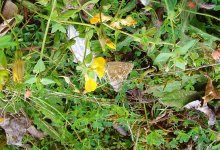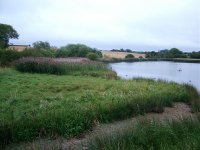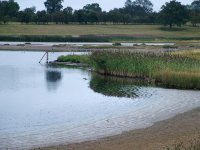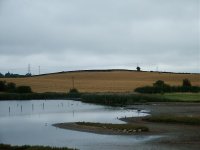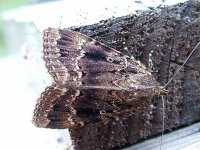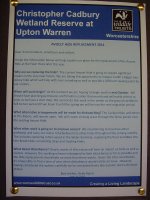upstarts1979
Well-known member
With the aforementioned Anniversary upon us, I couldn't risk lightening striking twice.
I arrived at 6am and made my way to the 1st Flash hide. On route the silence was deafening, apart from the soft churring of reed wablers in the scrub and a willow warbler in 'sub-song' ,it was eerily quiet. From the hide the soft mud around the southern shore of the 1st Flash held 2 green and 1 common sandpiper. (this area can hold waders when the 2nd Flash is dry - so try and check it out on route to the main hide). Moving on to the main hide a ringed plover called, from the hide I picked up 3 of them. The juv from previous days had been joined by 2 adults - these later flew off to the SW at 8.15. Although it had been raining in Redditch overnight, there hadn't been any here. However after Gert appeared the rain followed and was quite heavy, albeit of short duration. Small shallow pools quickly formed which were soon utilised by some of the 10 mixed flock of adult and juv green sands on site. Also on the wader front were Dunlin, common sand 2 (ad + juv), curlew 25, lapwing 50+, redshank juv. 9 Common terns were counted 3 ad and 3 juvs loafed on the mud whilst 3 other adults moved through to the south. With dark clouds forming to the east a flock of 10 swift hunted in front of them where there were also 40 or so house martins. Also recorded today were:- Mallard 500 (most in north field with 14 greylags where they fed on dropped seeds from the harvested crop, teal 7, 2 1st summer type Herring gulls, swallow hunting low over the pools, 2 Raven unusually both singularly, lesser whitethroat, blackcap, chiffchaff , 15 - 20 linnets with several juvs amongst them. 35 - 40 goldfinches. Generally passerine activity was poor, with the normally bustling hedgerow at the back of the hide almost lifeless. However the peak activity was centred on the 1st flash reedbed and hen brook, where good numbers of reed bunting and acro warblers as well as tits were evident. This area has to be 'scoped' but is traditionally good for whinchat, so try and give it a good 'grilling'. I get the impression that most of our warblers have left and this lull is a precursor to migrants arriving (hopefully) :smoke:
At this time migrant Sedge warblers should increase in the reed beds, where they feed on plum aphids, before moving on in a stages to the next reed bed. Unlike reed warblers, that will fatten up and migrate further, having less 'stop off's'.
Strangely there were only 7 birders other than Gert, Mark P and myself by 12pm, when Dave W arrived. Always remember Upton does this, it makes you think its dead and then it strikes. Early mornings are defo the best time.
B John
John
I arrived at 6am and made my way to the 1st Flash hide. On route the silence was deafening, apart from the soft churring of reed wablers in the scrub and a willow warbler in 'sub-song' ,it was eerily quiet. From the hide the soft mud around the southern shore of the 1st Flash held 2 green and 1 common sandpiper. (this area can hold waders when the 2nd Flash is dry - so try and check it out on route to the main hide). Moving on to the main hide a ringed plover called, from the hide I picked up 3 of them. The juv from previous days had been joined by 2 adults - these later flew off to the SW at 8.15. Although it had been raining in Redditch overnight, there hadn't been any here. However after Gert appeared the rain followed and was quite heavy, albeit of short duration. Small shallow pools quickly formed which were soon utilised by some of the 10 mixed flock of adult and juv green sands on site. Also on the wader front were Dunlin, common sand 2 (ad + juv), curlew 25, lapwing 50+, redshank juv. 9 Common terns were counted 3 ad and 3 juvs loafed on the mud whilst 3 other adults moved through to the south. With dark clouds forming to the east a flock of 10 swift hunted in front of them where there were also 40 or so house martins. Also recorded today were:- Mallard 500 (most in north field with 14 greylags where they fed on dropped seeds from the harvested crop, teal 7, 2 1st summer type Herring gulls, swallow hunting low over the pools, 2 Raven unusually both singularly, lesser whitethroat, blackcap, chiffchaff , 15 - 20 linnets with several juvs amongst them. 35 - 40 goldfinches. Generally passerine activity was poor, with the normally bustling hedgerow at the back of the hide almost lifeless. However the peak activity was centred on the 1st flash reedbed and hen brook, where good numbers of reed bunting and acro warblers as well as tits were evident. This area has to be 'scoped' but is traditionally good for whinchat, so try and give it a good 'grilling'. I get the impression that most of our warblers have left and this lull is a precursor to migrants arriving (hopefully) :smoke:
At this time migrant Sedge warblers should increase in the reed beds, where they feed on plum aphids, before moving on in a stages to the next reed bed. Unlike reed warblers, that will fatten up and migrate further, having less 'stop off's'.
Strangely there were only 7 birders other than Gert, Mark P and myself by 12pm, when Dave W arrived. Always remember Upton does this, it makes you think its dead and then it strikes. Early mornings are defo the best time.
B
Last edited:





